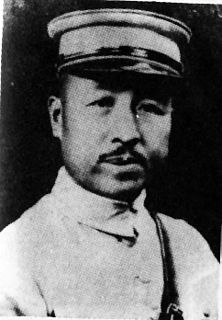Related Research Articles
The Battle of West Henan–North Hubei was one of the 22 major engagements between the National Revolutionary Army and Imperial Japanese Army during the Second Sino-Japanese War. It was fought in March–May 1945 in northern Hubei and western Henan. While it was a tactical stalemate, the battle was an operational victory for the Japanese forces, who seized control of local airbases, denying Chinese forces any localized air support.

The Battle of Wuyuan was a Chinese counterattack that defeated the Japanese invasion of the Wuyuan area. This happened in reaction to the Chinese 1939-40 Winter Offensive in Suiyuan during the Second Sino-Japanese War. The Japanese call it 第2次後套作戦.
Battle of Yunnan-Burma Road was the name of the Chinese intervention to aid their British allies in the 1942 Burma Campaign. Its forces were composed of the Fifth, Sixth and Sixty-sixth Army under the command of the Chinese Expeditionary Force in Burma, commanded by Lt. General Joseph Stilwell, Lt. General Luo Zhuoying was his Executive Officer.
The Swatow Operation was part of a campaign by Japan during the Second Sino-Japanese War to blockade China in order to prevent it from communicating with the outside world and importing needed arms and materials. Control of Swatow and its harbour would provide a base to make the blockade of Guangdong province more effective.
The order of battle for the Battle of South Guangxi by country is as follows:
Below is the order of battle for the Battle of Beiping-Tianjin, called the Peiking-Tientsin Operation in pinyin spelling, a series of battles fought from 25 July through 31 July 1937 as part of the Second Sino-Japanese War. It was called the North China Incident by the Japanese.

Shang Zhen was a general of the National Revolutionary Army during the Warlord Era, Second Sino-Japanese War and World War II. He was an early 20th century field general who won his share of wars and successful retreats. He then represented China's military in Washington and other international settings during World War II and post war Japan.
Below is the order of battle for the Amoy Operation fought May 10–12, 1938, part of a campaign by the Imperial Japanese Navy to blockade the Republic of China during the Second Sino-Japanese War.
The following units and commanders fought in the Battle of Lanfeng in May 1938.

The following units and commanders fought in the Battle of Changde in early November through late December 1943, part of the Second Sino-Japanese War.
This is the Battle of Pingxingguan order of battle during the Second Sino-Japanese War.
The Battle of Tachiao, was the first clash in the Battle of Yunnan-Burma Road in the Burma Campaign of World War II and Second Sino-Japanese War.
The Battle of Oktwin March 20–23, 1942, was the second battle in the Battle of Yunnan-Burma Road in the Burma Campaign of World War II and Second Sino-Japanese War.

Feng Qinzai 冯钦哉, or Feng Chin-Tsai (1887–1963) was a Lieutenant-General in the Chinese Army during the Second Sino-Japanese War.
Zhang Lingyun or Chang Ling-yun, was a general in the Chinese National Revolutionary Army during the Warlord era and Second Sino-Japanese War.
Men Bingyue was a general in the Chinese National Revolutionary Army during the Second Sino-Japanese War. As commander of the 7th Cavalry Division he participated in the Suiyuan Campaign in 1936, defeating the Japanese backed Inner Mongolian Army. After the beginning of the Second Sino-Japanese War in 1937 he was made Commander of the 6th Cavalry Army, fighting in the Battle of Taiyuan defending Suiyuan. In 1940 he was made Deputy Commander in Chief of the 17th Army Group. In 1941, he was made Commander of the 7th Cavalry Army. He died in August 1944 in Chongqing.
Hundred Regiments Offensive
Dissent in the Armed Forces of the Empire of Japan refers to serious cases of military insubordination within the institution, from the founding of the Empire of Japan in 1868 to its defeat during World War II in 1945.

Counter-Japanese Military and Political University, also commonly known as Kàngdà (抗大) and Kangri Junzheng University (抗日军政大学), was a comprehensive public university located in Yan'an, Shaanxi, the headquarters of the Chinese Communist Party during the Second Sino-Japanese War. Its former site has been converted to a memorial hall.
References
- ↑ Hsu Long-hsuen and Chang Ming-kai, History of The Sino-Japanese War Pg. 452.
- ↑ 抗日战争时期的侵华日军序列沿革 (Order of battle of the Japanese army that invaded China during the Sino Japanese War) Archived July 7, 2011, at the Wayback Machine
- ↑ Hsu Long-hsuen and Chang Ming-kai, History of The Sino-Japanese War Pg. 453